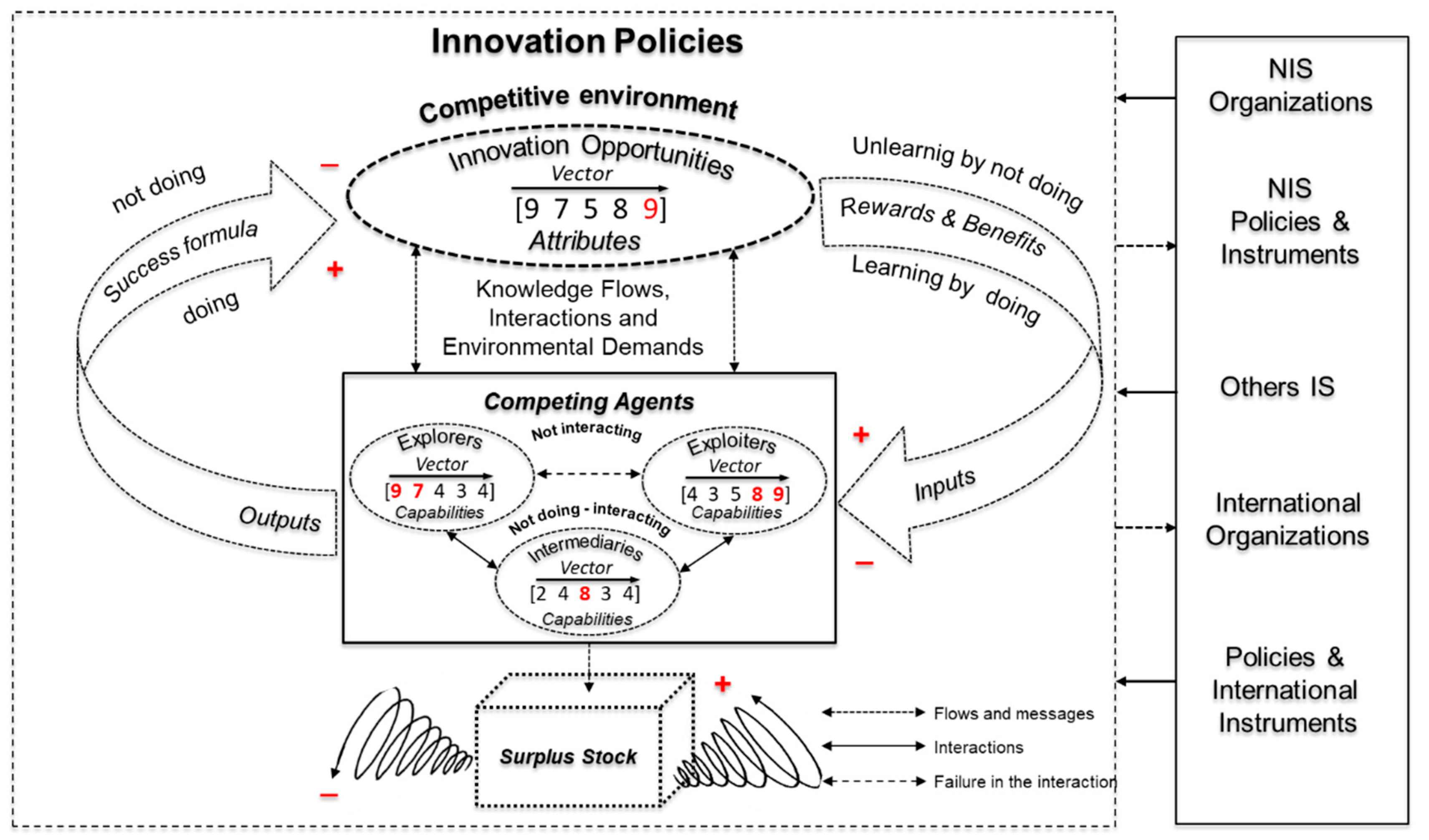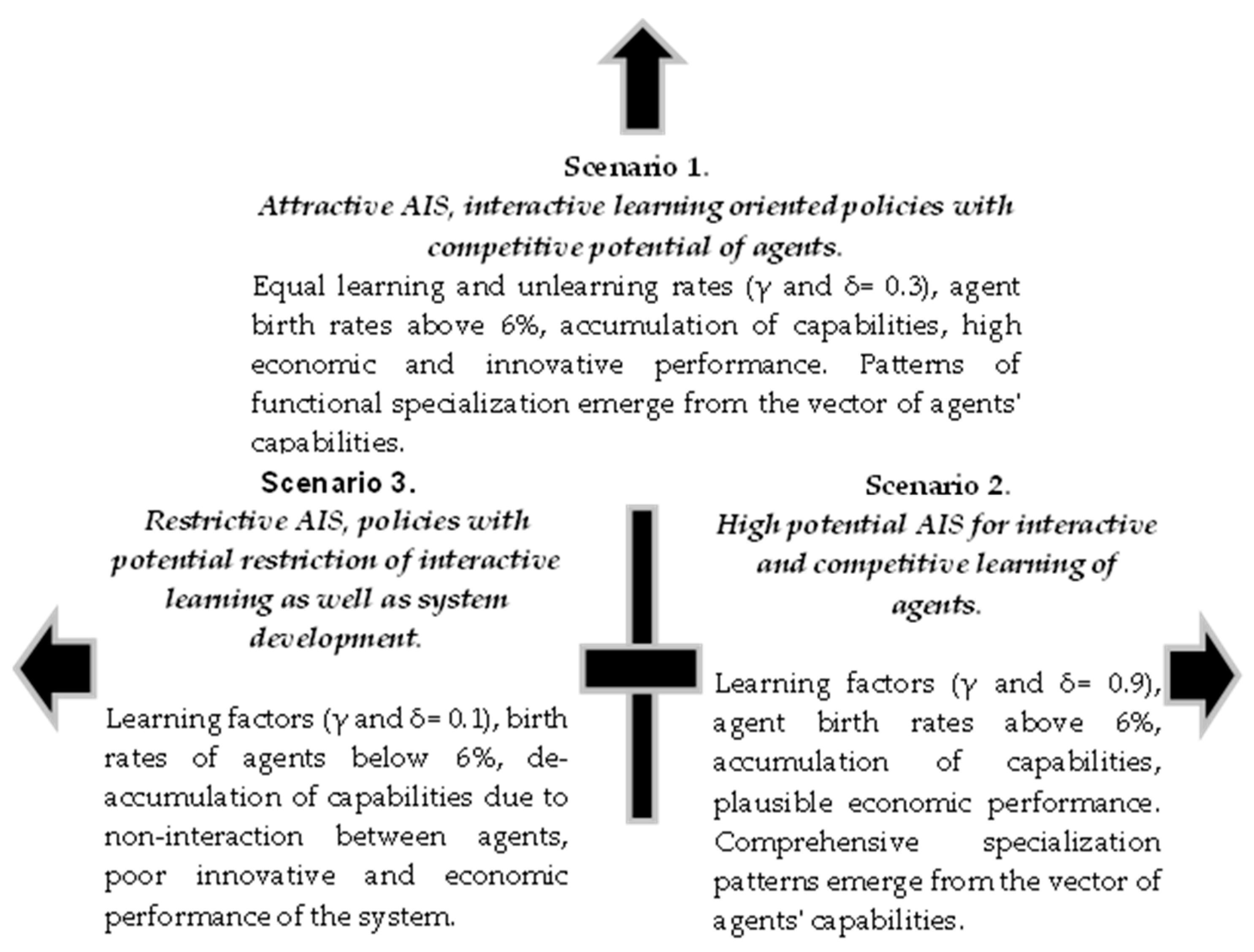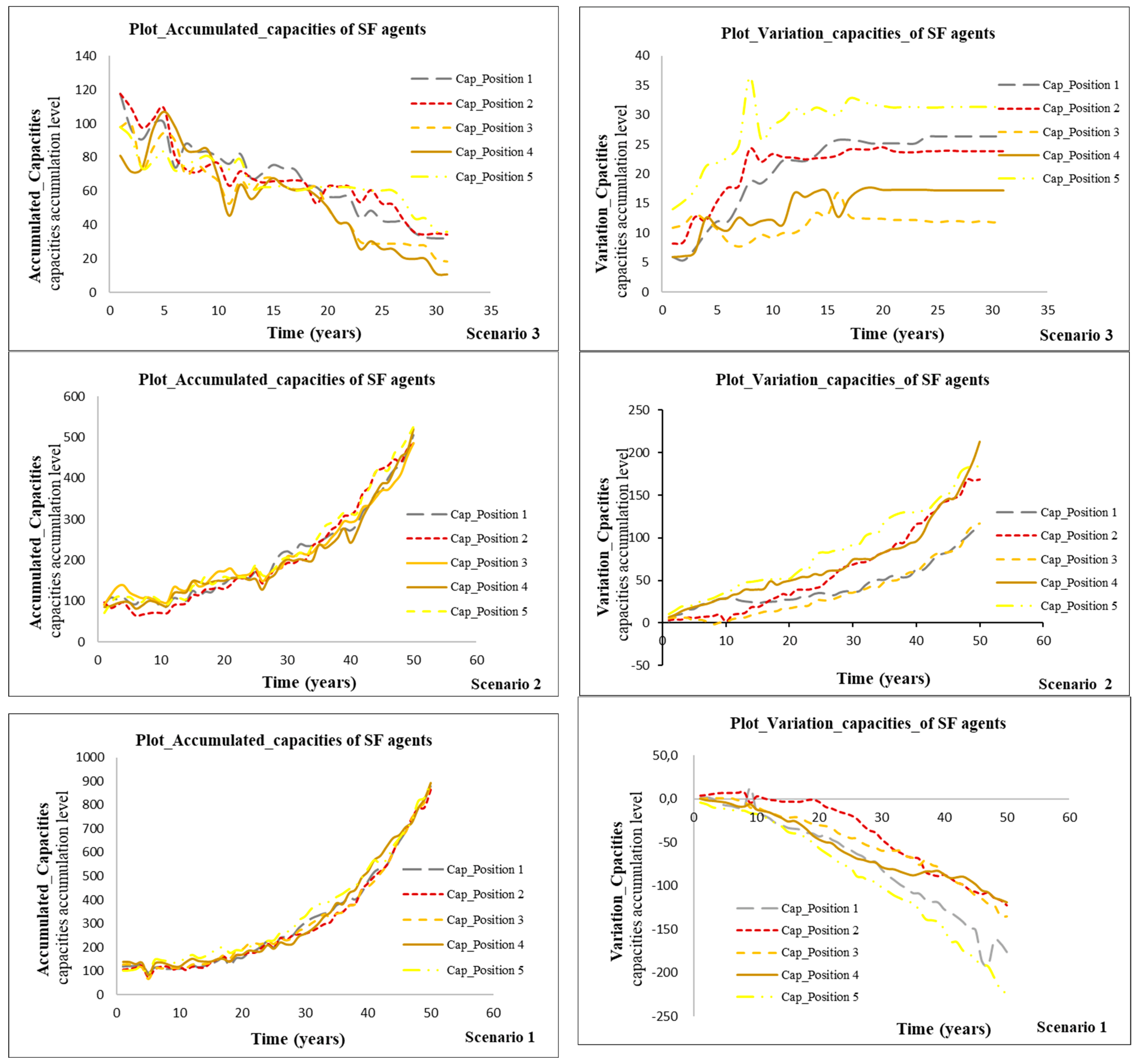Analysis of the Specialization Patterns of an Agricultural Innovation System: A Case Study on the Banana Production Chain (Colombia)
Abstract
1. Introduction
2. Conceptual Model
2.1. Model Assumptions
2.2. Model Logic
3. Model Parameterization and Implementation
Results
4. Discussion of Results
5. Conclusions and Future Works
Author Contributions
Funding
Institutional Review Board Statement
Informed Consent Statement
Data Availability Statement
Acknowledgments
Conflicts of Interest
References
- Holland, J.H.; Miller, J.H. Artificial Adaptive Agents in Economic Theory. Am. Econ. Rev. 1991, 81, 365–370. [Google Scholar]
- Holland, J.H. Hidden Order: How Adaptation Builds Complexity; Addison Wesley Longman Publishing: Boston, MA, USA, 1996; ISBN 978-0201442304. [Google Scholar]
- Lättilä, L.; Hilletofth, P.; Lin, B. Hybrid Simulation Models—When, Why, How? Expert Syst. Appl. 2010, 37, 7969–7975. [Google Scholar] [CrossRef]
- Iammarino, S. An Evolutionary Integrated View of Regional Systems of Innovation: Concepts, Measures and Historical Perspectives. Eur. Plan. Stud. 2005, 13, 497–519. [Google Scholar] [CrossRef]
- Uyarra, E. What Is Evolutionary about ‘Regional Systems of Innovation’? Implications for Regional Policy. J. Evol. Econ. 2010, 20, 115–137. [Google Scholar] [CrossRef]
- Klerkx, L.; Aarts, N.; Leeuwis, C. Adaptive Management in Agricultural Innovation Systems: The Interactions between Innovation Networks and Their Environment. Agric. Syst. 2010, 103, 390–400. [Google Scholar] [CrossRef]
- Pietrobelli, C.; Rabellotti, R. Global Value Chains Meet Innovation Systems: Are There Learning Opportunities for Developing Countries? World Dev. 2011, 39, 1261–1269. [Google Scholar] [CrossRef]
- Alexander, C.; Ishikawa, S.; Silverstein, M.; Jacobson, M.; Fiksdahl-King, I.; Angel, S. A Pattern Language: Towns, Buildings, Construction; Oxford University Press: New York, NY, USA, 1977; 313p. [Google Scholar]
- Teece, D.J.; Pisano, G.; Shuen, A. Dynamic Capabilities and Strategic Management. Strateg. Manag. J. 1997, 18, 509–533. [Google Scholar] [CrossRef]
- Lund, R. The Organization of Actors’ Learning in Connection With New Product Development. Res. Technol. Innov. Manag. Policy 2004, 8, 129–153. [Google Scholar] [CrossRef]
- Lundvall, B.-Å.; Vinding, A.L. Product Innovation and Economic Theory—User-Producer Interaction in the Learning Economy. In Product Innovation, Interactive Learning and Economic Performance; Emerald Publishing Limited: Bingley, UK, 2004; p. 361. [Google Scholar]
- Gilsing, V.; Nooteboom, B. Exploration and Exploitation in Innovation Systems: The Case of Pharmaceutical Biotechnology. Res. Policy 2006, 35, 1–23. [Google Scholar] [CrossRef]
- Klerkx, L.; Leeuwis, C. Establishment and Embedding of Innovation Brokers at Different Innovation System Levels: Insights from the Dutch Agricultural Sector. Technol. Forecast. Soc. Chang. 2009, 76, 849–860. [Google Scholar] [CrossRef]
- Ponsiglione, C.; Quinto, I.; Zollo, G. Bridging the SKIN Model to the Debate on Territorial Innovation Systems: The Proposal of an Agent-Based Model of Self-Sustained Regional Innovation Systems. In 3rd SKIN Workshop: Joining Complexity Science and Social Simulation for Policy; Eötvös Loránd University: Budapest, Hungary, 2014. [Google Scholar]
- Quintero, S. Aprendizaje En Los Sistemas Regionales de Innovación: Un Modelo Basado En Agentes. Ph.D. Thesis, Universidad Nacional, Bogota, Colombia, 2016. [Google Scholar]
- Elsenbroich, C.; Gilbert, N. Modelling Norms; Springer: Dordrecht, The Netherlands, 2014; ISBN 978-94-007-7051-5. [Google Scholar]
- Kiesling, E.; Günther, M.; Stummer, C.; Wakolbinger, L.M. Agent-Based Simulation of Innovation Diffusion: A Review. Cent. Eur. J. Oper. Res. 2012, 20, 183–230. [Google Scholar] [CrossRef]
- Scalco, A.; Ceschi, A.; Sartori, R. Application of Psychological Theories in Agent-Based Modeling: The Case of the Theory of Planned Behavior. Nonlinear Dyn. Psychol. Life Sci. 2018, 22, 15–33. [Google Scholar]
- Railsback, S.F.; Grimm, V. Agent-Based and Individual-Based Modeling: A Practical Introduction; Princeton University Press: Princeton, NJ, USA, 2011; ISBN 978-0-691-19082-2. [Google Scholar]
- Huseien, G.F.; Shah, K.W. Potential Applications of 5G Network Technology for Climate Change Control: A Scoping Review of Singapore. Sustainability 2021, 13, 9720. [Google Scholar] [CrossRef]
- TradeMap Trade Statistics for International Business Development. Available online: https://www.trademap.org/ (accessed on 16 June 2022).
- Agronet Resultados de Las Evaluaciones Agropecuarias. Available online: https://www.agronet.gov.co/estadistica/paginas/home.aspx?cod=59 (accessed on 1 January 2020).
- Sargent, R.G. Verification and Validation of Simulation Models. J. Simul. 2013, 7, 12–24. [Google Scholar] [CrossRef]
- Robledo Velásquez, J.; López, C.; Zapata, W.; Pérez, J.D. Desarrollo de Una Metodología de Evaluación de Capacidades de Innovación. Perf. Coyunt. Econ. 2011, 15, 133–148. [Google Scholar]
- Nadler, D.A.; Tushman, M.L. A Congruence Model for Organizational Assessment. Organ. Assess. Perspect. Meas. Organ. Behav. Qual. Work life 1980, 261, 278. [Google Scholar]
- Quintero Ramírez, S.; Ruiz Castañeda, W.L.; Robledo Velásquez, J. Representation of Unlearning in the Innovation Systems: A Proposal from Agent-Based Modeling. Estud. Gerenc. 2017, 33, 366–376. [Google Scholar] [CrossRef]
- Quintero, S.; Ruiz Castañeda, W.L.; Giraldo Ramírez, D.P.; Vélez Acosta, L.M.; Marín Sánchez, B.M. Modelo de Transferencia de Tecnología Para Las Cadenas Productivas Agropecuarias: Análisis Comparativo de Las Cadenas Del Café y El Aguacate En Antioquia; Universidad Pontificia Bolivariana: Medellin, Colombia, 2019; ISBN 978-958-764-755-6. [Google Scholar]
- Quintero, S.; Ruíz-Castañeda, W.; Cubillos Jiménez, S.; Marín Sánchez, B.M.; Giraldo, D.P.; V´élez Acosta, L.M. Medición de Las Capacidades Tecnológicas Para La Innovación En Los Sistemas de Conocimiento e Innovación Agrícola. Cienc. Tecnol. Agropecu. 2021, 22, 1–22. [Google Scholar] [CrossRef]
- Ahrweiler, P.; Pyka, A.; Gilbert, N. Simulating Knowledge Dynamics In Innovation Networks (Skin). In Industry And Labor Dynamics The Agent-Based Computational Economics Approach; World Scientific Book Chapters; World Scientific Publishing Co. Pte. Ltd.: Singapore, 2004; pp. 284–296. [Google Scholar]
- Padgett, J.F. Economic Production as Chemistry. Ind. Corp. Chang. 2003, 12, 843–877. [Google Scholar] [CrossRef][Green Version]
- Padgett, J.F.; McMahan, P.; Zhong, X. Economic Production as Chemistry II. In The Emergence of Organizations and Markets; Princeton University Press: Princeton, NJ, USA, 2012; pp. 70–91. [Google Scholar]
- Ponsiglione, C.; Quinto, I.; Zollo, G. Regional Innovation Systems as Complex Adaptive Systems: The Case of Lagging European Regions. Sustainability 2018, 10, 2862. [Google Scholar] [CrossRef]
- Edquist, C. Systems of Innovation Approaches—Their Emergence and Characteristics. In Systems of Innovation: Technologies, Institutions and Organizations; Routledge: London, UK, 1997; pp. 1–35. ISBN 978-1855674523. [Google Scholar]
- Lundvall, B.-Å. National Systems of Innovation: Towards a Theory of Innovation and Interactive Learning; Pinter Publishers: London, UK, 1992. [Google Scholar]
- Rothwell, R. Towards the Fifth-generation Innovation Process. Int. Mark. Rev. 1994, 11, 7–31. [Google Scholar] [CrossRef]
- Simon, H.A. Rational Choice and the Structure of the Environment. Psychol. Rev. 1956, 63, 129–138. [Google Scholar] [CrossRef] [PubMed]
- Quintero, S.; Robledo, J. Sistemas Regionales de Innovación: Un Análisis Del Marco Conceptual y Referencial de Los Fenómenos Emergentes y Sus Redes de Trabajo Colaborativas a Partir de Vigilancia Tecnológica. In III Congreso Internacional de Gestión Tecnológica e Innovación. Gestión de la Tecnología y la Innovación Para la Competitividad en Mercados Abiertos; Universidad Pontifica Bolivariana: Medellin, Colombia, 2018. [Google Scholar]
- Quintero, S.; Robledo, J. El Aprendizaje Como Propiedad Emergente En Los Sistemas Regionales de Innovacion. In XV Congresso da Associação Latino-Iberoamericana de Gestão de Tecnologia, ALTEC; Centro de Estudos em Inovação, Tecnologia e Políticas de Desenvolvimento, Instituto Superior Tecnico: Lisboa, Portugal, 2013; pp. 1077–1092. [Google Scholar]
- Teece, D.J. Technological Change and the Nature of the Firm. In Technical Change and Economic Theory; Dosi, G., Freeman, C., Nelson, R., Silverberg, G., Soete, L., Eds.; Pinter Publishers: London, UK, 1988. [Google Scholar]
- Jensen, M.B.; Johnson, B.; Lorenz, E.; Lundvall, B.Å. Forms of Knowledge and Modes of Innovation. Res. Policy 2007, 36, 680–693. [Google Scholar] [CrossRef]
- Lundvall, B. National Innovation Systems—Analytical Concept and Development Tool. Ind. Innov. 2007, 14, 95–119. [Google Scholar] [CrossRef]
- Doing Business. Grupo Del Banco Mundial: Doing Business. 2013. Available online: https://www.doingbusiness.org/content/dam/doingBusiness/media/Annual-Reports/English/DB13-full-report.pdf (accessed on 17 May 2020).
- Hobday, M. Innovation in East Asia: The Challenge to Japan; Elgar, E., Ed.; University of Hawai’i Press: Honolulu, HI, USA, 1997. [Google Scholar]
- Kim, L. Imitation to Innovation: The Dynamics of Korea’s Technological Learning; Harvard Business Review Press, Ed.; Harvard Business School Press: Boston, MA, USA, 1997; ISBN 978-0875845746. [Google Scholar]
- Fritsch, M.; Slavtchev, V. Determinants of the Efficiency of Regional Innovation Systems. Reg. Stud. 2011, 45, 905–918. [Google Scholar] [CrossRef]
- Cooke, P. Regional Innovation Systems, Clusters, and the Knowledge Economy. Ind. Corp. Chang. 2001, 10, 945–974. [Google Scholar] [CrossRef]
- Howells, J. Intermediation and the Role of Intermediaries in Innovation. Res. Policy 2006, 35, 715–728. [Google Scholar] [CrossRef]
- Davis, J.P.; Eisenhardt, K.M.; Bingham, C.B. Developing Theory Through Simulation Methods. Acad. Manag. Rev. 2007, 32, 480–499. [Google Scholar] [CrossRef]




| Variables | Description |
|---|---|
| Vectors l = 5 | Chain length of attributes or capabilities vectors. Each position is related to an attribute for the functions of generation (research and development), diffusion (intermediation), and use (production and marketing). |
| Magnitudes | Represent the degree of development of each vector position and includes values between 0–9. |
| Birth rate | Represents the percentage of agents and innovative opportunities that are created in the system at each tick for the SESRA model, of 6% and 12%, respectively, according to data from the World Bank [42]. |
| Learning rate (γ) | Represents the speed with which capacities are accumulated in each position of the vector of attributes in time t (years). For the model, it will take values between 0.1–0.9. |
| lct | It refers to the time in which an innovative opportunity remains in the environment, delivering benefits to the agents identifying and exploiting it. For the model, it will take a random value with Gaussian behavior. |
| Reward income (IA) | Refers to the income or reward (monetary units) that the innovative opportunity provides to the agent identifying and exploiting it in one or more vector positions. |
| Cost (Ct) | The cost (monetary units) that the agent incurs to stay in the environment. This depends proportionally on each magnitude of the capabilities vector. |
| Surplus stock SSt | Economic resources (monetary units) with which agents are born in the environment. This allows them to interact dynamically with other agents to identify and exploit opportunities, and also addresses the accumulation or deaccumulation of capabilities. For the model, this takes a random value between 0 and 255 units. |
| Factors | Scenario | Capabilities | Learning | Unlearning | Inventory | |
|---|---|---|---|---|---|---|
| Factor levels | 1 | Attractive AIS | R&D | 0.3 | 0.3 | 1, 2, 3,…2600 |
| 2 | High potential AIS | Resources Management | 0.9 | 0.9 | ||
| 3 | Restrictive AIS | Intermediation | 0.1 | 0.1 | ||
| 4 | Production | |||||
| 5 | Marketing | |||||
Publisher’s Note: MDPI stays neutral with regard to jurisdictional claims in published maps and institutional affiliations. |
© 2022 by the authors. Licensee MDPI, Basel, Switzerland. This article is an open access article distributed under the terms and conditions of the Creative Commons Attribution (CC BY) license (https://creativecommons.org/licenses/by/4.0/).
Share and Cite
Quintero, S.; Giraldo, D.P.; Garzon, W.O. Analysis of the Specialization Patterns of an Agricultural Innovation System: A Case Study on the Banana Production Chain (Colombia). Sustainability 2022, 14, 8550. https://doi.org/10.3390/su14148550
Quintero S, Giraldo DP, Garzon WO. Analysis of the Specialization Patterns of an Agricultural Innovation System: A Case Study on the Banana Production Chain (Colombia). Sustainability. 2022; 14(14):8550. https://doi.org/10.3390/su14148550
Chicago/Turabian StyleQuintero, Santiago, Diana P. Giraldo, and William Orjuela Garzon. 2022. "Analysis of the Specialization Patterns of an Agricultural Innovation System: A Case Study on the Banana Production Chain (Colombia)" Sustainability 14, no. 14: 8550. https://doi.org/10.3390/su14148550
APA StyleQuintero, S., Giraldo, D. P., & Garzon, W. O. (2022). Analysis of the Specialization Patterns of an Agricultural Innovation System: A Case Study on the Banana Production Chain (Colombia). Sustainability, 14(14), 8550. https://doi.org/10.3390/su14148550





